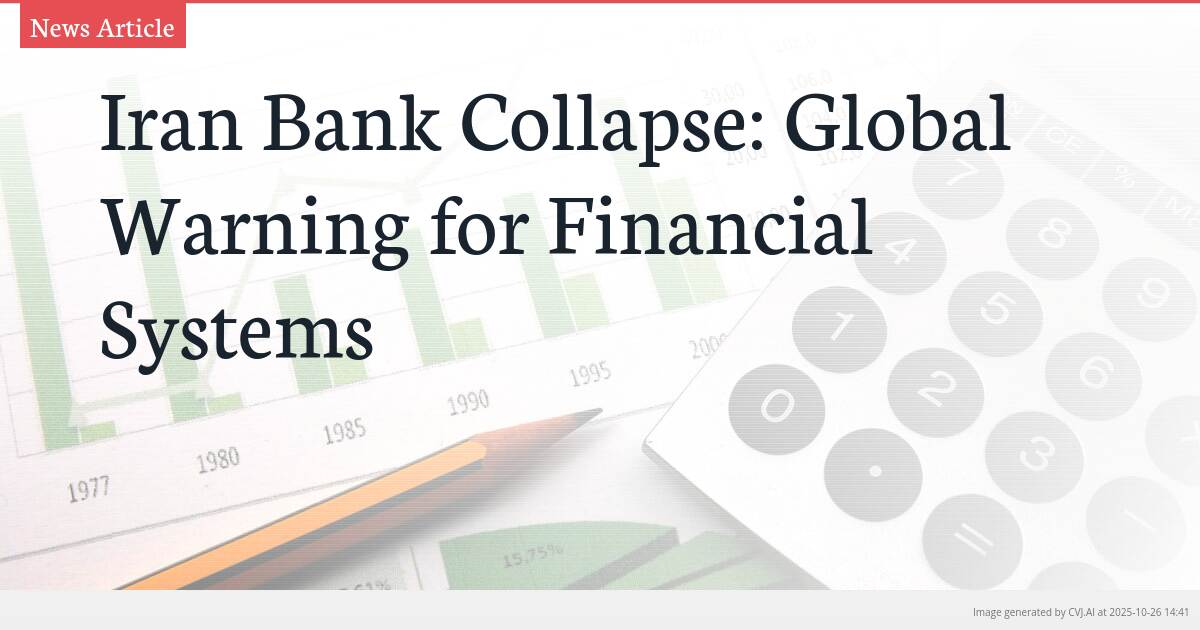This summary text is fully AI-generated and may therefore contain errors or be incomplete.
Introduction
Iran’s financial system has been rocked by the dramatic collapse of Ayandeh Bank, one of the country’s largest private lenders, exposing deep vulnerabilities in both emerging and developed financial markets. The bankruptcy, involving $5.2 billion in losses and $3 billion in debt absorbed by state-owned Melli Bank, occurs amid Iran’s simultaneous hyperinflation and severe recession, with depositors facing limited insurance coverage of just $930. This crisis highlights Bitcoin’s emerging role as a hedge against systemic financial risk, mirroring recent U.S. banking failures and revealing the universal fragility of trust in traditional finance.
Key Points
- Ayandeh Bank accumulated $5.2 billion in losses primarily from opaque loans to politically connected projects, with 90% of funds going to affiliated companies that never repaid
- Iranian depositors face severe limitations with insured deposits capped at approximately $930 and payout processes that can take years, leaving larger savers potentially uncompensated
- U.S. regional banks continue showing financial stress with rising loan defaults and delinquencies despite post-2023 crisis measures, prompting expectations of new merger waves
The Ayandeh Bank Implosion: A Domestic Crisis with Global Echoes
Iran’s Central Bank declared Ayandeh Bank, one of its largest private lenders with over 270 branches nationwide, bankrupt in one of the country’s most dramatic financial implosions in years. Founded in 2012, the bank had accumulated staggering losses of $5.2 billion and nearly $3 billion in debt, according to Asharq Al-Awsat. The state-owned Melli Bank has absorbed its assets, with officials promising depositors their savings are “secure,” but Iranians have learned to temper such assurances as lines quickly formed outside shuttered Ayandeh branches in Tehran.
The collapse follows years of poor governance and opaque loans to politically connected projects, including the debt-ridden Iran Mall mega-complex. More than 90% of the bank’s funds reportedly went to affiliated companies that never repaid, creating a massive hole in its balance sheet. For ordinary Iranians, the real fear isn’t corporate losses but access to their savings. Insured deposits in Iran are capped at just 1 billion rials (roughly $930), and payout processes can take years, leaving those holding larger amounts potentially never seeing their money again.
This domestic crisis unfolds against a backdrop of broader economic turmoil, with Iran’s economy teetering under simultaneous hyperinflation and severe recession, squeezed further by a snapback of U.N. sanctions and a collapsing rial. The Ayandeh Bank failure represents more than just a single institution’s collapse—it exposes systemic weaknesses that resonate across global financial markets.
Parallels in Developed Markets: U.S. Banking Stress Continues
Iran’s banking crisis finds disturbing parallels in developed markets, particularly the United States, where the shock failures of Silicon Valley Bank, Signature Bank, and First Republic Bank in 2023 became the biggest cluster of collapses since 2008. Even as the FDIC and Treasury guaranteed deposits, thousands of startups, small businesses, and uninsured clients were left scrambling, revealing similar vulnerabilities in supposedly more stable financial systems.
According to a Morningstar report published in October 2025, U.S. regional banks continue to show growing signs of financial stress, even after boosting reserves and shoring up deposits following the 2023 banking crisis. Delinquencies and loan defaults are rising amid persistent inflation, elevated borrowing costs, and losses tied to lower-income borrowers. Although balance sheets appear stronger on paper, confidence remains fragile, with market volatility this quarter pushing bank stocks lower before a partial recovery on better-than-expected earnings.
Analysts now expect a new wave of regional bank mergers and acquisitions as larger players move to absorb weaker rivals, suggesting the underlying stress in the system persists. These developments demonstrate that financial fragility isn’t confined to emerging markets or sanctioned economies but represents a broader challenge to traditional banking models worldwide.
Bitcoin as Financial Insurance: Beyond Counterparty Risk
What makes these crises rhyme across Tehran and San Francisco isn’t geography or ideology but the fundamental fragility of trust in centralized financial systems. Whether in Iran or the United States, savers face counterparty risk every time they deposit funds into institutions dependent on state rescue. The repeated pattern of bank failures, capital controls, and potential confiscations eventually follows financial repression, wherever it arises.
Bitcoin represents a fundamental alternative to this paradigm. It doesn’t ask users to trust a central authority because there isn’t one—no bank to freeze funds, no government to quietly inflate savings away. The cryptocurrency operates beyond borders and politics, moving freely where traditional finance cannot. When banks fail, the promises behind account balances can vanish overnight, but when individuals hold Bitcoin themselves, there’s no counterparty, just mathematical certainty that doesn’t break its word.
For millions watching savings vaporize through no fault of their own, from Iranian depositors facing years of uncertainty to U.S. businesses caught in the 2023 banking crisis, Bitcoin is increasingly seen not as speculation but as insurance against the system itself. The Ayandeh Bank collapse serves as a global warning about the inherent vulnerabilities of traditional finance and strengthens the case for seizure-proof alternatives that operate outside centralized control.
📎 Read the original article on cryptoslate.com

